Italy by Design. Five Boutique Hotels Redefining Style Through Craft, Light and Atmosphere
A journey through five Italian boutique hotels where light, craft and atmosphere shape a new idea of design. Rome, Tuscany, Piedmont and the Amalfi Coast told through interiors that inspire and stay with you.
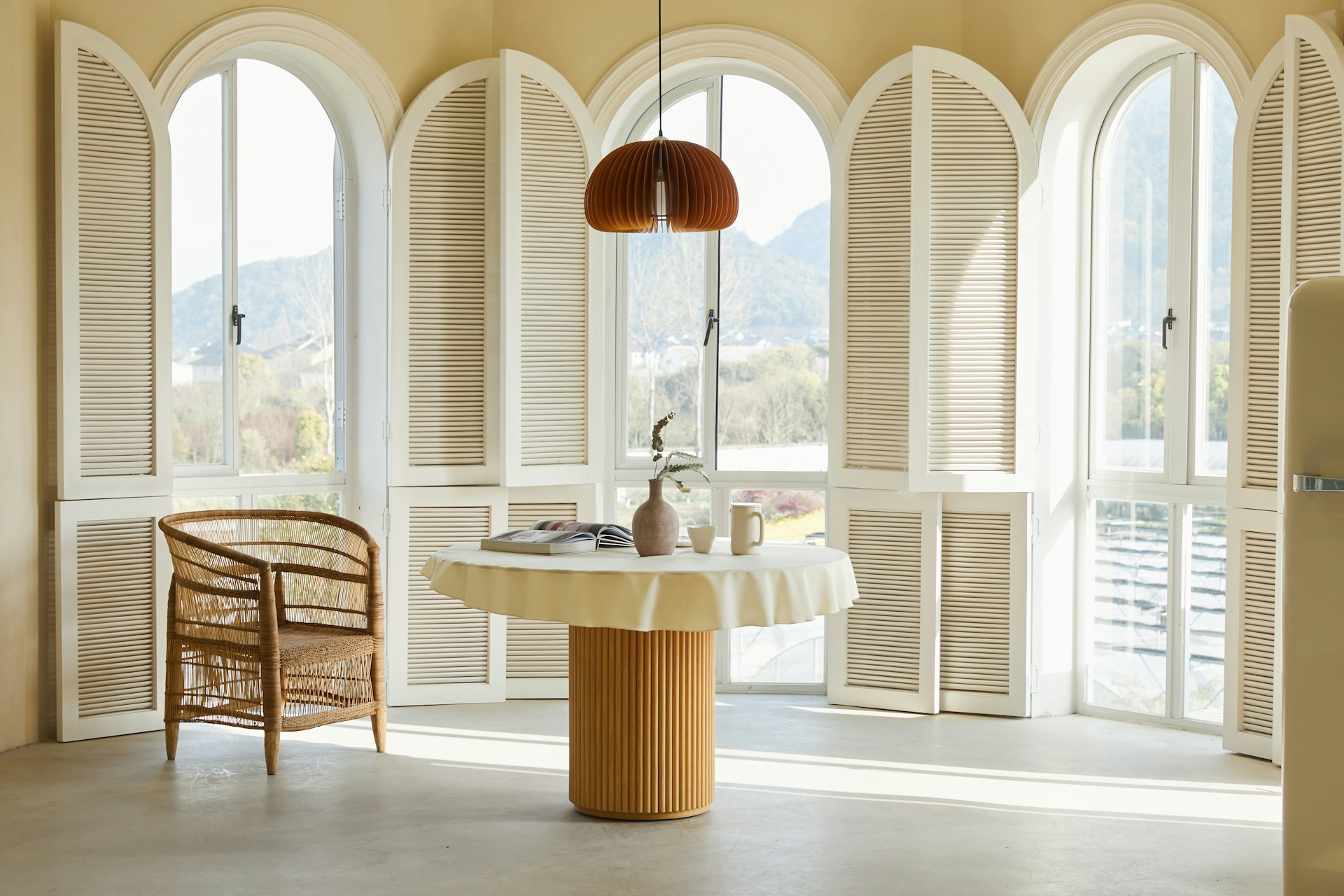
Beauty in Italy does not shout. It settles into places the way light settles over a tiled courtyard or the way a piece of linen softens after years of use. It emerges in the texture of stone, in quiet palettes, in rooms shaped more by feeling than by rules. Italian design has always understood this, but the country’s new wave of boutique hotels is refining it even further. These places do not imitate what came before. They look inward. They look outward. They look around. Their strength lies in intention more than excess.
Travelling through Italy today means stepping into spaces where craftsmanship meets comfort, where heritage is not polished into something anonymous, and where the landscape sets the rhythm. These five hotels show how design is evolving across the country. Each one is different, but all share the same instinct. They make you want to stay a little longer. They make you pay attention to details you did not expect to notice. They remind you that design, when done well, is something you feel long before you analyse it.
Casa Monti, Rome
Rome is a city of layers, and Casa Monti mirrors that beautifully. Designed by Laura González, the hotel feels like a Roman townhouse reimagined through a modern, artistic lens. You notice it as soon as you enter. Colours are warm but not predictable. Soft pinks, deep greens and burnt ochres appear in fabrics, tiles and hand finished paint. The atmosphere is expressive without being theatrical. Nothing looks mass produced. Everything feels chosen.
Rooms are filled with custom headboards, patterned textiles and sculptural lighting. Rather than chasing minimalism, the interiors embrace personality. You see brass touches that catch the afternoon sun, curved shapes that soften the structure of the rooms and pieces of furniture that feel collected rather than bought all at once. The result is a setting that is elegant but disarmingly warm, like staying in the home of someone with impeccable taste who does not take themselves too seriously.
The neighbourhood adds a layer of authenticity. Monti is creative without being performative. You hear conversations spilling out of wine bars, smell espresso from small cafés and walk past ateliers where artisans still work by hand. Casa Monti fits into this rhythm naturally. It does not need to pretend to be Roman. It simply is.
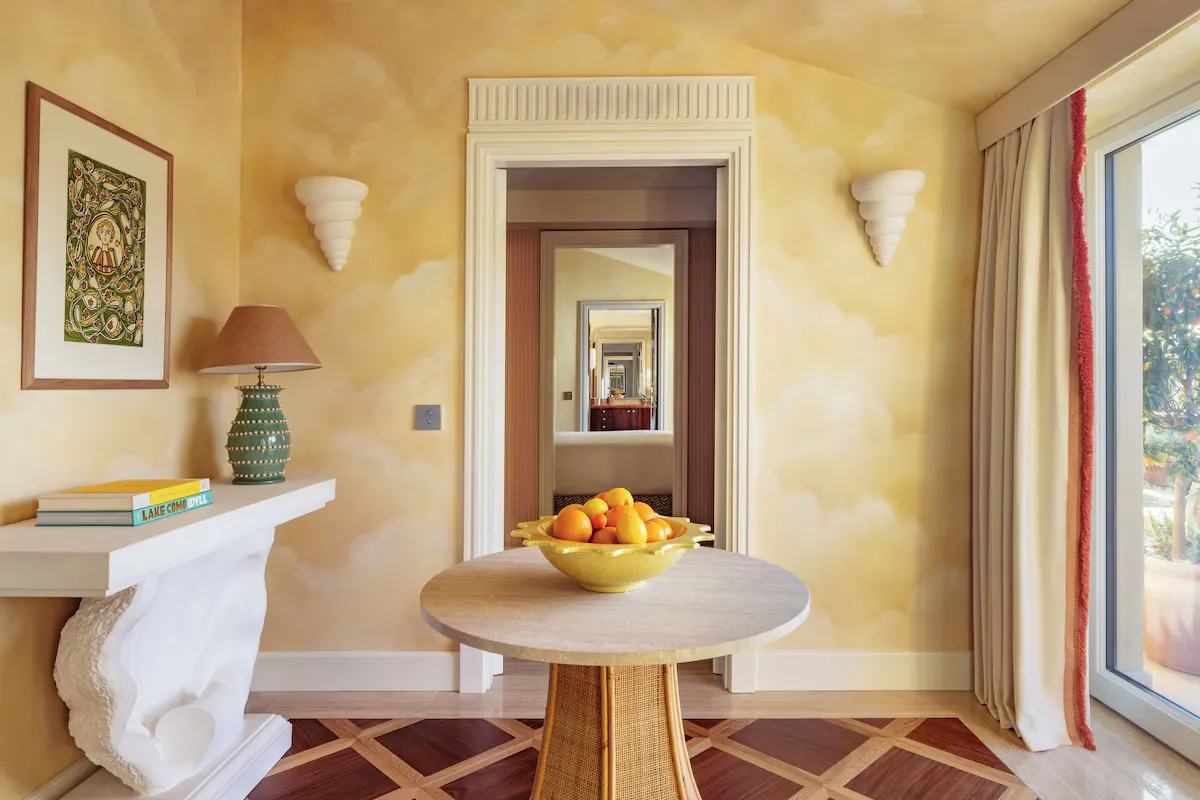
Relais Le Due Matote, Piedmont
Piedmont understands silence. It understands slowness, light, stone and the kind of natural elegance that cannot be staged. Relais Le Due Matote embodies all of this. The hotel is set in seventeenth century buildings restored with respect for their origins. From the outside, you see historic stone, wooden shutters and the kind of proportions typical of rural Piemonte. Inside, the design stays true to the architecture. Vaulted ceilings, terracotta floors and natural fabrics create an atmosphere that is serene rather than stylised.
The design choices never feel forced. Colours stay close to the earth. Beige, cream and soft grey appear in linens and plastered walls, while wooden beams and original stonework provide texture. There is a sense of integrity in every space. Chairs are comfortable without being imposing, lighting is soft and warm, and nothing interrupts the feeling that you are staying inside a piece of local history.
The surroundings contribute greatly to the experience. Vineyards and rolling hills dominate the landscape, and the air has that clean, slightly cool scent that only the Piedmontese countryside possesses. Relais Le Due Matote is not a place that tries to impress you. It invites you to slow down and pay attention to the subtler parts of luxury, the ones you notice in the quiet.
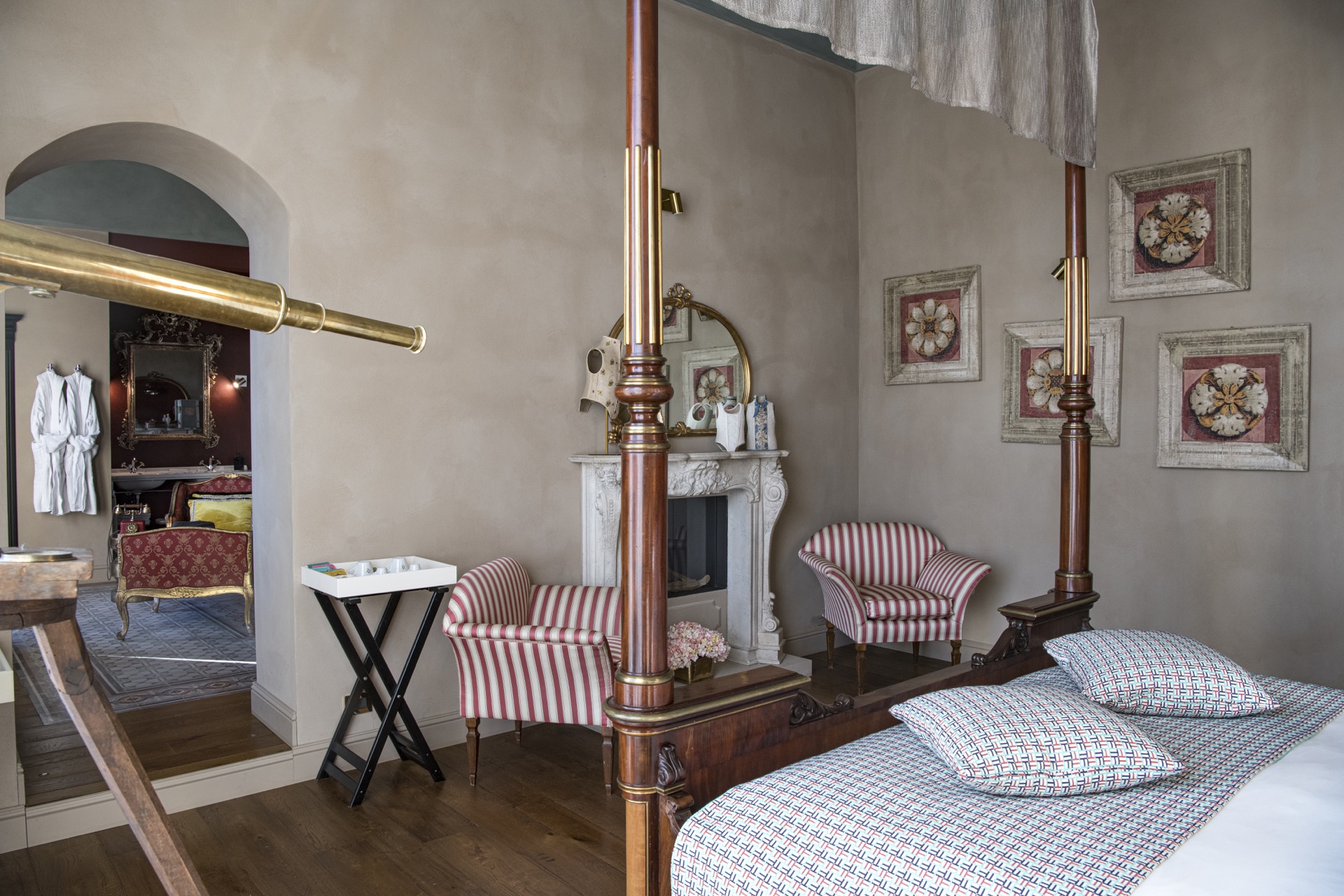
Capo La Gala, Campania
Some hotels belong to the sea, and Capo La Gala is one of them. Built into the rocky coastline near Vico Equense, the property follows the natural shapes of the cliffs. You see this in the architecture, which uses bright whites, rounded forms and local stone details that mirror the colours of the Amalfi Coast. The design draws the eye outward. Rooms feel open. Terraces extend into the view. The sea becomes part of the interior.
Inside, the marine inspired palette is evident. White walls and blue accents create a sense of freshness familiar to Mediterranean homes. Furniture is simple and functional, avoiding visual clutter, and the overall effect is calming. You feel the light more than you see it. It spreads across tiled floors and reflects gently off pale curtains, giving the rooms an airy quality that suits the coastline.
Much of the hotel’s charm lies in the transition between indoors and outdoors. You wake to the sound of the waves, walk along pathways built into the rock and spend afternoons on terraces where the horizon feels close enough to touch. Capo La Gala does not try to reinterpret the sea. It gives it space, and that is what makes the design work.
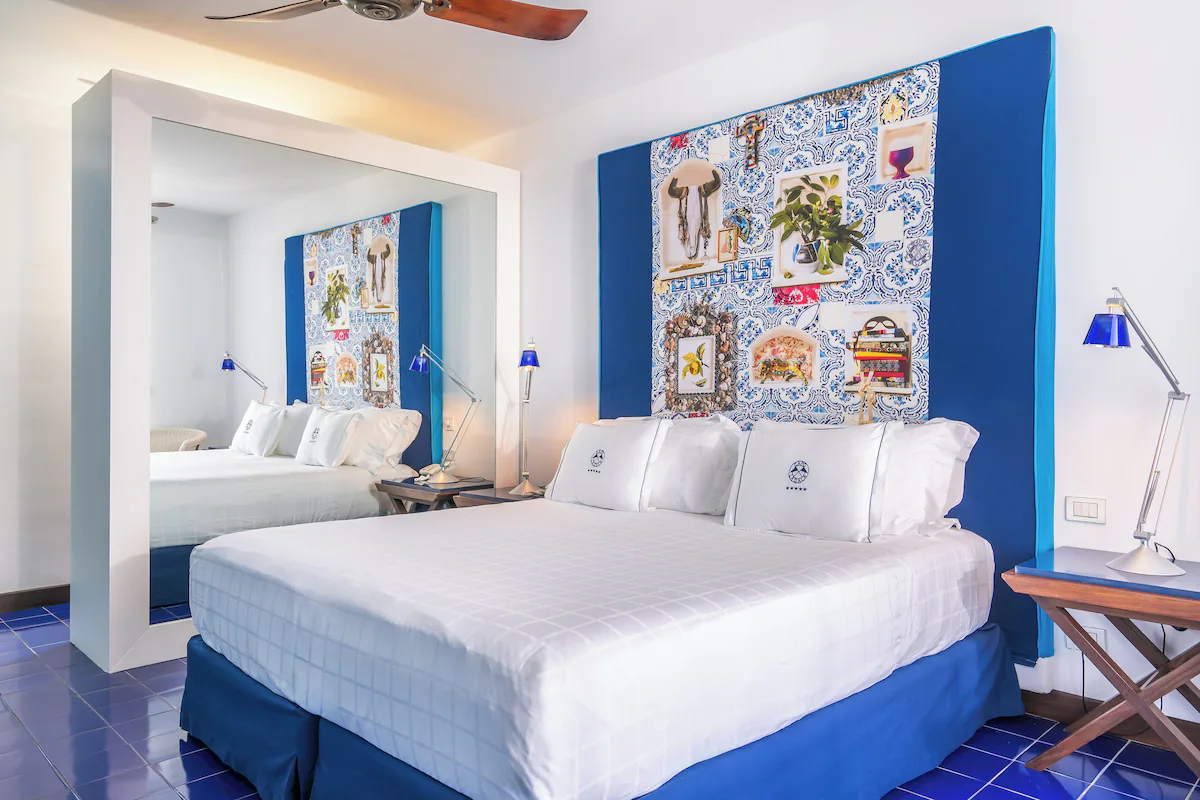
Locanda al Colle, Tuscany
In the hills above Camaiore, Locanda al Colle stands out for a style that feels effortless. The property resembles the home of an art collector with a love for mid century design and a strong sense for atmosphere. Inside, each room is different. You will find vintage chairs, handcrafted ceramics, contemporary paintings and textiles that add warmth without overwhelming the space. The design is eclectic in theory but harmonious in practice.
Colours are earthy with occasional bold accents. Ochre, olive, stone grey and muted blues create a sense of continuity between indoors and the surrounding landscape. Lighting is deliberately gentle. Lamps glow rather than shine, and shadows fall softly on textured walls. Nothing feels clinical or over curated. The charm of Locanda al Colle lies in its personality. It feels lived, layered and thoughtful.
The outdoor spaces reinforce the intimacy of the interior. Terraces open onto gardens filled with Mediterranean plants, lavender and olive trees. The pool area is quiet and framed by greenery. Even the breeze here seems slower. Locanda al Colle is one of those places where the design quietly shapes your day without demanding your attention. You feel its effect rather than analysing it.
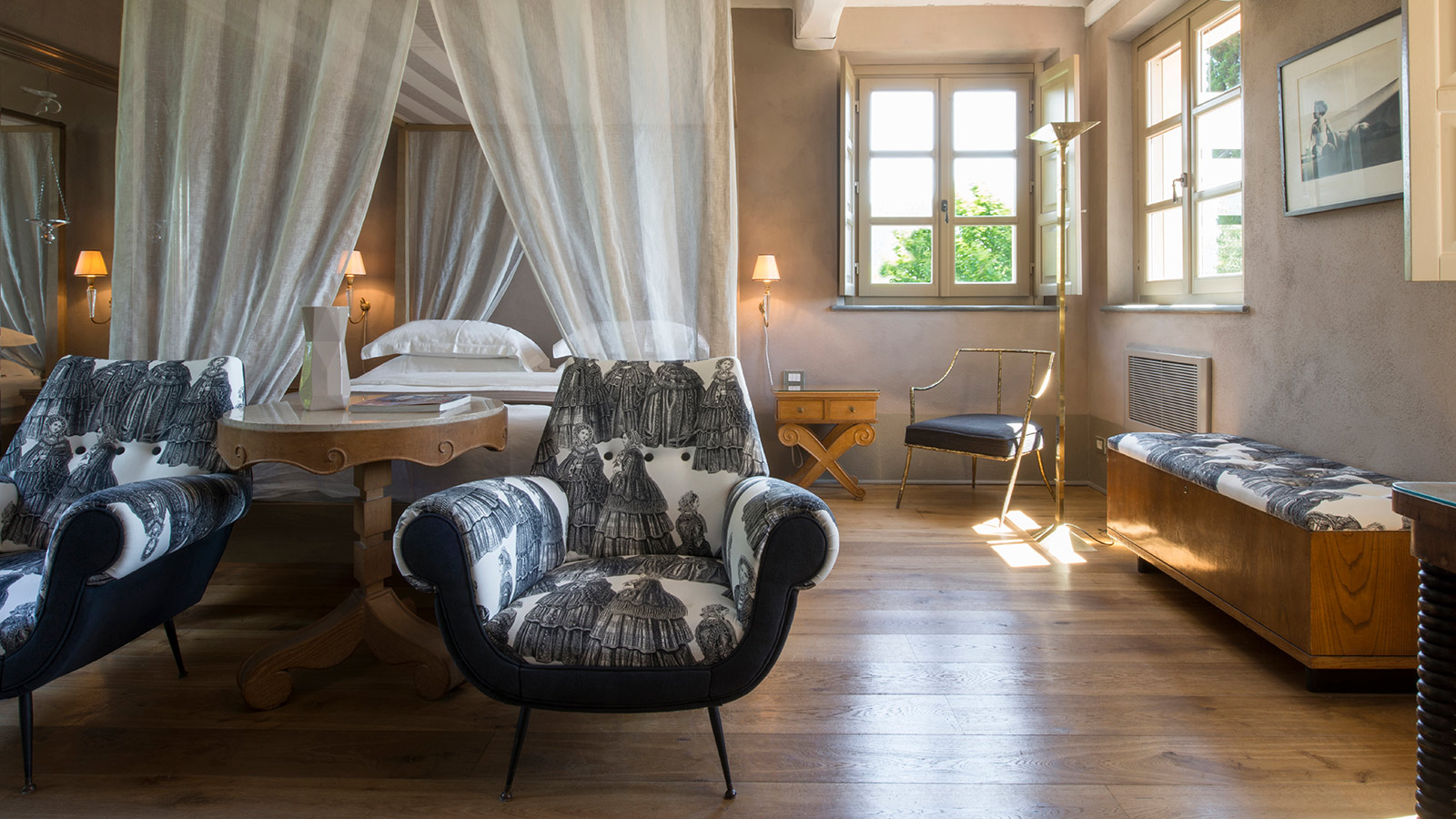
Hotel Villa Franca, Positano
Positano is famous for its views, but Hotel Villa Franca adds a contemporary perspective to the classic Amalfi aesthetic. Perched high above the town, the property combines modern lines with bright interiors and curated artworks. The first impression is light. Sunlight moves through the rooms easily thanks to pale walls, reflective surfaces and wide windows that frame the cliffs and the sea below.
The design vocabulary is clean but not cold. Whites and neutrals dominate, complemented by subtle touches of colour in textiles and art. Furniture is elegant in a way that feels functional rather than ornamental. You notice how spacing between objects contributes to the sense of calm. Nothing is overfilled. Nothing feels rushed. Air and light do much of the work.
The rooftop terrace is the hotel’s defining feature. From here, Positano spreads beneath you like a mosaic of pastel houses and narrow streets. The pool mirrors the sky, and the horizon appears almost seamless. This interplay between architecture and landscape is what makes Hotel Villa Franca stand out. It respects the vertical drama of Positano while refining the experience into something more understated and modern.
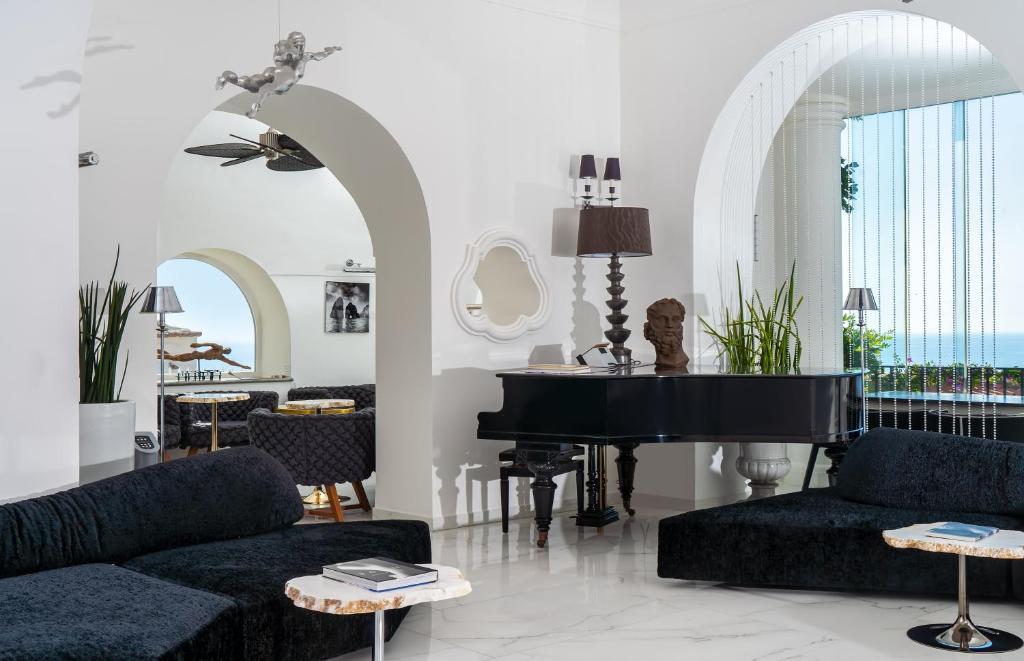
What These Five Hotels Say About Italian Design Today
The beauty of Italian design lies in its variety. There is no single definition that fits every region, and that is precisely why the country remains one of the world’s most compelling destinations for design led travel.
Casa Monti shows the creative, expressive side of Rome. Relais Le Due Matote embodies discreet luxury shaped by heritage. Capo La Gala reveals how architecture can respond to the coastline without overwhelming it. Locanda al Colle demonstrates how art and vintage elements can coexist naturally. Hotel Villa Franca presents a cleaner, contemporary version of Amalfi elegance.
None of these hotels feel similar, but all share the same approach. They treat design as a form of hospitality. They use materials honestly, work with their surroundings, and create spaces that reflect personality rather than formula. In a country where beauty is everywhere, these hotels prove that design still has the power to surprise.
FAQ
What defines a true design hotel in Italy?
A real design hotel focuses on atmosphere, materials and sense of place rather than trends or excess. Interiors feel intentional, crafted and connected to the region.
Which of these hotels is best for a romantic stay?
Casa Monti suits couples who love culture and city life. Locanda al Colle is perfect for slow days in nature. Hotel Villa Franca offers panoramic sunset views over Positano.
Is Capo La Gala good for travellers who want to stay close to the sea?
Yes, the hotel sits directly on the coastline and many rooms open onto terraces facing the Gulf of Naples.
Which hotel is best for design lovers who enjoy art and vintage pieces?
Locanda al Colle, thanks to its blend of vintage furniture, curated artworks and warm, layered interiors.
Do these boutique hotels stay open all year?
Some do, especially city hotels like Casa Monti. Coastal and countryside stays may open seasonally, so it is best to check each hotel’s official calendar.
How early should I book these design hotels?
For destinations like Positano or Tuscany, several months in advance is ideal. Rome and Piedmont offer more flexibility but booking early gives better room selection.